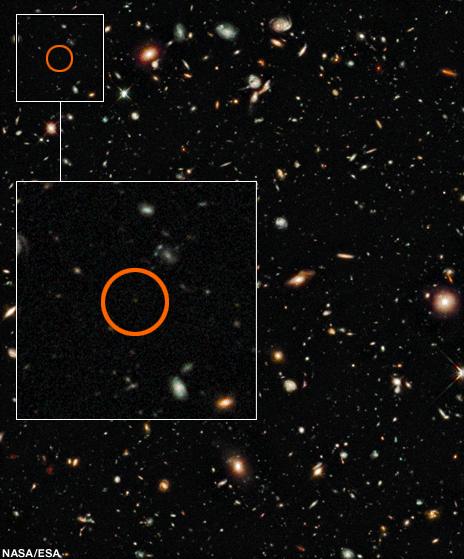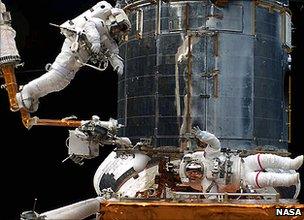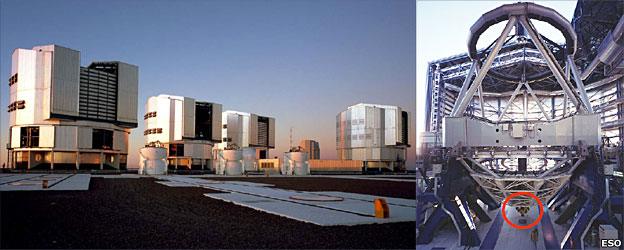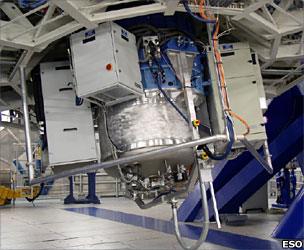Galaxy is most distant object yet
- Published

A tiny faint dot in a Hubble picture has been confirmed as the most distant galaxy ever detected in the Universe.
This collection of stars is so far away its light has taken more than 13 billion years to arrive at Earth.
Astronomers used the Very Large Telescope in Chile to follow up the Hubble observation and make the necessary detailed measurements.
They tell the journal Nature that we are seeing the galaxy as it was just 600 million years after the Big Bang.
"If you look at the object in the Hubble image, it really isn't much," said Dr Matt Lehnert of the Observatoire de Paris, France, and lead author on the Nature paper, external.
"We really don't know much about it, but it looks like it is quite small - much, much smaller than our own Milky Way Galaxy. It's probably got only a tenth to a hundredth of the stars in the Milky Way. And that's part of the difficulty in observing it - if it's not big, it's not bright," he told BBC News.
Scientists are very keen to probe these great distances because they will learn how the early Universe evolved, and that will help them explain why the cosmos looks the way it does now.
In particular, they want to see more evidence for the very first populations of stars. These hot, blue giants would have grown out of the cold neutral gas that pervaded the young cosmos.

The Wide Field Camera 3 was fitted to Hubble during its last servicing mission
These behemoths would have burnt brilliant but brief lives, producing the very first heavy elements.
They would also have "fried" the neutral gas around them - ripping electrons off atoms - to produce the diffuse intergalactic plasma we still detect between nearby stars today.
So, apart from its status as a record-breaker, the newly discovered Hubble galaxy, classified as UDFy-38135539, is of keen interest because it is embedded directly in this time period - the "epoch of re-ionisation", as astronomers call it.
The galaxy was one of several interesting candidates identified in the Hubble Ultra Deep Field (UDF) image of the Fornax Constellation acquired with the telescope's new Wide Field Camera 3 last year.
As a source of light, it barely registers on the Hubble picture which was made from an exposure lasting 48 hours.

The four 8.2m telescopes of the VLT. Yepun is the far-right unit. Sinfoni is circled at its base in the inset
Astronomers knew from the UDF data that the galaxy must be very far away, but it took some exquisite measurements using the Yepun Very Large Telescope unit on Mount Paranal in the Atacama Desert to determine the precise distance.
This was done using the Sinfoni instrument attached to Yepun. The spectrograph was able to pick apart the weak infrared light and establish the degree to which it had been stretched on its long journey through space and time by the expansion of the Universe.
Using this measure, known as redshift, the astronomers could confirm that UDFy-38135539 was more than 13 billion light-years distant (a redshift of 8.55).
Dr Andy Bunker from Oxford University, UK, worked with one of the Hubble teams that first spotted the galaxy. He said Lehnert and colleagues had made a compelling case for the object's great distance.
"These things are incredibly faint and far away," he commented. "You're talking about an emission line that's a small fraction of the brightness of the night sky and you have to be very careful in your measurement; but this group is careful. The result looks convincing," he said.

It required the exquisite capabilities of the Sinfoni instrument to confirm the galaxy's great distance
A redshift of 8.55 puts the galaxy firmly within the epoch of re-ionisation.
At this early time, theory indicates, the Universe would not have been fully transparent. Much of it would have been filled with a hydrogen "fog" that absorbed the fierce ultraviolet light coming off the young galaxies.
Only as these galaxies ionised this neutral gas filling the space between them did their light sweep out across the cosmos.
One of the more puzzling aspects of the discovery is that the glow from UDFy-38135539 would not have been strong enough on its own to burrow a path through the opaque hydrogen fog.
This means there must be fainter, less massive galaxies - unseen in the Hubble UDF - helping to clear out the neighbourhood.
Professor Malcolm Bremer of Bristol University, UK, is a co-author on the Nature paper. He explained the importance of these distant objects to astronomy:
"They're beautiful probes of our understanding of galaxy formation because we're seeing them at their earliest stages and therefore, hopefully, at their simplest," he said.
"If we want to believe we understand galaxy formation and evolution, then we would want to be able to say that the observed properties in these early galaxies are what we've been predicting. We want to see the start of the process," he told BBC News.
These observations on both Hubble and the VLT push current technology to the limit.
Astronomers have other candidates of similar distance in the UDF they hope to confirm soon. However, the real breakthrough in observing the epoch of re-ionisation is probably going to have to wait until more powerful telescopes and techniques are established.
This next-generation astronomy will include Hubble's successor (the James Webb Space Telescope) and the Extremely Large Telescope (ELT) to be built near the VLT in Chile.
The ELT will catch the faintest starlight with a mirror some 42m across. That is five times the diameter of Yepun's primary mirror.